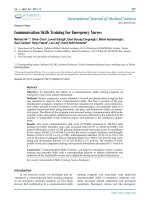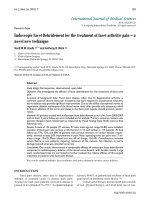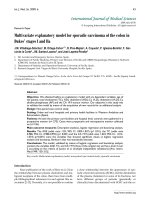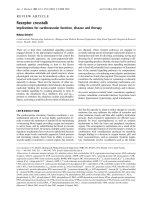Báo cáo y học: "Communication Skills Training For Emergency Nurses"
Bạn đang xem bản rút gọn của tài liệu. Xem và tải ngay bản đầy đủ của tài liệu tại đây (298.71 KB, 5 trang )
Int. J. Med. Sci. 2011, 8
397
I
I
n
n
t
t
e
e
r
r
n
n
a
a
t
t
i
i
o
o
n
n
a
a
l
l
J
J
o
o
u
u
r
r
n
n
a
a
l
l
o
o
f
f
M
M
e
e
d
d
i
i
c
c
a
a
l
l
S
S
c
c
i
i
e
e
n
n
c
c
e
e
s
s
2011; 8(5):397-401
Research Paper
Communication Skills Training For Emergency Nurses
Mehmet Ak
1
, Orhan Cinar
2
, Levent Sutcigil
1
, Emel Dovyap Congologlu
1
, Bikem Haciomeroglu
1
,
Hayri Canbaz
2
, Hulya Yaprak
2
, Loni Jay
3
, Kamil Nahit Ozmenler
2
1. Department of Psychiatry, Gulhane Military Medical Academy, GATA Psikiyatri AD.06018 Etlik, Ankara, Turkey
2. Department of Emergency Medicine, Gulhane Military Medical Academy, GATA Psikiyatri AD.06018 Etlik, Ankara,
Turkey
3. The University of Utah School of Medicine, Utah, USA.
Corresponding author: Mehmet AK, MD, Assistant Professor, E-mail: , ; Phone:
00905056000681
© Ivyspring International Publisher. This is an open-access article distributed under the terms of the Creative Commons License (
licenses/by-nc-nd/3.0/). Reproduction is permitted for personal, noncommercial use, provided that the article is in whole, unmodified, and properly cited.
Received: 2011.05.10; Accepted: 2011.05.31; Published: 2011.06.22
Abstract
Objective: To determine the effects of a communication skills training program on
emergency nurses and patient satisfaction.
Methods: Sixteen emergency nurses attended a 6-week psychoeducation program that
was intended to improve their communication skills. The first 3 sessions of the psy-
choeducation program consisted of theoretical education on empathy and communica-
tion. Other sessions covered awareness, active communication, and empathic skills on a
cognitive behavioral basis using discussion, role play, and homework within an interac-
tive group. The effects of the program were assessed using a communication skills scale,
empathy scale, and patient satisfaction survey and were reflected by the reduction in the
number of undesirable events between nurses and patients in the emergency depart-
ment.
Results: The mean communication skill score (177.8±20) increased to 198.8±15 after
training (p=0.001). Empathy score also increased from 25.7±7 to 32.6±6 (p=0.001). The
patient satisfaction survey of 429 patients demonstrated increased scores on confidence
in the nurses (76.4±11.2 to 84.6±8.3; p=0.01); the nurse’s respect, kindness, and thought-
fulness (72.2± 8.1 to 82.1 ± 6,5; p=0.01); individualized attention (71.3± 6.2 to 73.2 ± 9.8;
p=0.2); devotion of adequate time to listening (84.6± 9.3 to 89.8 ± 7.6; p=0.03); and coun-
seling and information delivery (71.1± 10.2 to 80.2 ± 9.7; p=0.01). The number of unde-
sirable events and complaints during nurse-patient interactions decreased 66 % from 6 to
2.
Conclusion: ―Communication Skills Training‖ can improve emergency nurses’ commu-
nication and empathy skills with a corresponding increase in patient satisfaction and
reduction of the undesirable events and complaints during nurse-patient interactions.
Key words: Communication Skills, Training, Nurses, Emergency
Introduction
In our previous study, we developed and ad-
ministered a communication skills training program
to our emergency medicine residents (1). Our study
showed that participation in a communication skills
training program was associated with improved
communication skills of emergency medicine resi-
dents, increased patient satisfaction and decreased
complaints. Emergency nurses, just like emergency
Ivyspring
International Publisher
Int. J. Med. Sci. 2011, 8
398
physicians, need special communication skills that
can affect both their professional success as well as
patient satisfaction.
Emergency nurses have multiple challenging
responsibilities including dealing with overstressed
patients and their relatives, the homeless, mentally ill
patients, victims etc. They must perform these re-
sponsibilities in a short period of time in the busy
environment of the emergency department (ED). It is
also well known that poor communication can effect
patient satisfaction, which is becoming an increas-
ingly important measure of performance in today’s
patient-oriented health care systems (2).
Communication skills can be summarized as
sensitivity to verbal and nonverbal messages, effective
listening and responding (3). Despite the views which
support that communication skills are innate and in-
tuitive, many studies have proven that various com-
ponents of communication techniques can be learned
and teachable (4). Although the expectation is that
communication skills are acquired by nursing stu-
dents during nursing education programs, some de-
scriptive studies indicated that there remains a train-
ing inadequacy (5-6).
We aimed to determine the effectiveness of a
6-week communication skills training program in
emergency nurses by addressing the following ques-
tions: What is the current level of communication
skills and empathy in emergency nurses? Does this
training program increase their communication skills
and empathy? Will this training program affect pa-
tient satisfaction? And, will this training program
decrease both the number of undesirable events be-
tween nurses and patients and the number of patients’
complaints?
MATERIALS AND METHOD
Participants
The study included sixteen emergency nurses in
the GATA Department of Emergency Medicine. Fol-
lowing approval from the local ethics committee, a
psychoeducation program that was intended to im-
prove communication and empathy skills in emer-
gency nurses was held for 6 weeks (90 minutes per
week).
Patient satisfaction surveys on the nurse-patient
relationship were filled out by patients who presented
to the ED within the previous 2 months (April
2010–May 2010) and after completion of the program
(July 2010–September 2010). Patient satisfaction scores
before and after the training were compared to de-
termine significant changes. Surveys were delivered
to patients or their families after completion of their
respective procedures in the ED or when the decision
to discharge or admit had been made. The patients
were informed that the survey was not mandatory
and were asked to leave completed surveys in a des-
ignated box.
The number of undesirable events between
emergency nurses and patients or relatives and the
number of patient complaints were retrieved from the
registry of the administrative office of the ED. All
events that were reported by nurses and all com-
plaints by the patients about the nurses were noted for
analysis.
Training Program
In our previous study, we developed and used a
communication skills program to our emergency
medicine resident successfully. The same training
program was modified and used for emergency
nurses (1). There were some reasons of the modifica-
tion of the previous training program. First of all, the
second part of the training program was composed of
discussions and role plays which require active par-
ticipation of the trainees. Since the doctors and nurses
experience different problems during their interac-
tions with the patients and/or their relatives, different
scenarios were prepared for doctors and nurses
group. At the beginning of these studies, the re-
searchers have also thought to give this psychoedu-
cation to emergency medicine residents and nurses
together. However, when the undesirable events in
the emergency department were analyzed, it was seen
that doctors and nurses diversed in the conflict areas
during their patient interactions. This might be due to
the differences between the two professions in terms
of their responsibility areas. Therefore, the case ex-
amples might not lead to similar empathic associa-
tions in a doctor-nurse mixed trainee group. So, the
emergency medicine residents and nurses took dif-
ferent psychoeducation trainings only in terms of case
scenarios, role plays and discussions specifically de-
signed for their professions. Moreover, since our
training program includes active participation, small
number of interaction groups was especially pre-
ferred.
The psychoeducation program was developed
based on theoretical adult learning principles and
incorporating effective elements for delivery of
communication skills training; the content and pro-
cess was specifically designed for this study and was
based on best available evidence. The curriculum of
the training program was presented in our previous
study (1).
The first 3 sessions of the psychoeducation pro-
gram consisted of theoretical education on empathy,
Int. J. Med. Sci. 2011, 8
399
communication, and relationships between the pa-
tient and health care team. Other sessions covered
dominant, passive, and aggressive communication
types and the differences between them; and verbal
and nonverbal communication, active listening, rec-
ognizing and understanding feelings, expression of
feelings and thoughts, identification with others, and
establishing empathy—all of which were intended to
improve awareness, active communication, and em-
pathic skills on a cognitive behavioral basis using
discussion, role play, and homework within an inter-
active group.
Workshops were also held, presenting case ex-
amples that represented the communication problems
that are encountered frequently in EDs. All partici-
pants were asked to note their experiences on the
subjects that were discussed before the next session,
when these experiences were discussed.
Effectiveness of the psychoeducation program
was assessed using a communication skills inventory
and empathy scales for nurses and satisfaction sur-
veys for patients before and after the program. In ad-
dition, sociodemographic data forms were filled out
by patients and the nurses who participated in the
psychoeducation program.
Assessment Tools
Communication skills inventory:
The Communication Skills Inventory (CSI) was
developed by Ersanli and Balci (7). The first version of
the inventory, for which validity and reliability stud-
ies have been performed, consisted of 70 items. Sub-
sequently, the inventory was given to 500 university
students, and total number of items was reduced to 45
after an analysis of factors (3). The inventory
measures the mental, emotional, and behavioral as-
pects of communication. Higher scores on each di-
mension or higher total scores reflect better commu-
nication skills. The total score ranges from 45 to 225.
Empathy Scale:
This scale was developed by Lawrence et al. to
measure empathic attitudes (8) The psychometric
characteristics of Turkish samples were studied by
Bora and Baysan (9). The original scale consisted of 60
items, 40 of which measured empathy; the remaining
20 items prevented participants from focusing on the
objectives of the test. The total score ranges from 0 to
44.
A short version has been developed using the 22
items that measure empathy (10). The short version
was used in this study. A reliability study of the short
form in Turkish samples generated a Cronbach alfa
value of 0.814. The total score for items on the short
form correlates significantly with that of the long ver-
sion (r=0.90, p<0.0001). The test-retest correlation is
r=0.72 (9).
Sociodemographic Data Collection Form:
This form was used to collect data from nurses
who participated in the study on age, gender, marital
status, number of children, and their level of
knowledge on communication skills.
Patient Satisfaction Survey:
This survey consisted of 2 sections. The first sec-
tion recorded patient data, such as age, gender, level
of education, profession, symptoms, time of admis-
sion, length of stay in the ED, number of admissions
to the ED, established diagnosis, presence of chronic
disease, and any problem that was experienced in the
ED. In the second section, patients were asked to
evaluate their nurses with regard to their confidence,
respect, and kindness; individualized attention; de-
votion of time to listening; and counseling on the
disease and treatment, rating them on a Visual Analog
Scale from 0 to 100.
Statistical Analysis
Statistical analysis was performed using SPSS for
Windows 15.0. (SPSS Inc, Chicago, IL). Data are pre-
sented as mean, standard deviation, and percentage.
Data on the nurses were compared by t-test between
dependent groups and by Wilcoxon signed ranks test,
and data from the patient satisfaction survey were
compared between independent groups by t-test. A
p-value of <0.05 was considered statistically signifi-
cant.
RESULTS
Sixteen emergency nurses from the GATA
Emergency Medicine Department participated in the
training program. The mean age of the nurses was
30.4 ± 5.2 years, and all were female. None of the
nurses had attended a training program, and 4 nurses
had read a book on communication skills and empa-
thy. The mean communication skill score (177,8±20)
increased to 198,8±15 after training (p=0.001). Empa-
thy score also increased from 25.7±7 to 32.6±6
(p=0.001).
The changes in pre- and posttraining scores on
the satisfaction surveys from 429 patients were as
follows, respectively: confidence in the nurse in-
creased from 76.4±11.2 to 84.6±8.3, p=0.01; the respect,
kindness, and thoughtfulness of the nurses climbed
from 72.2± 8.1 to 82.1 ± 6.5, p=0.01; time devoted to
listening increased from 84.6± 9.3 to 89.8 ± 7.6, p=0.03;
and the counsel that was provided by the nurses in-
Int. J. Med. Sci. 2011, 8
400
creased from 71.1± 10.2 to 80.2 ± 9.7, p=0.01. Individ-
ualized attention from the nurses was comparable
between groups. (71.3± 6.2 vs 73.2 ± 9.8, p=0.2)
The comparison of pre- and posttraining scores
on communication skills, empathy, and patient satis-
faction is presented in Table 1. The sociodemographic
data of patients who filled out patient satisfaction
surveys in the 2 months before and after the training
are shown in Table 2. The 2 groups were comparable
with regard to the variables that were examined.
The number of undesirable events and com-
plaints during nurse-patient interactions decreased 66
% from 6 to 2.
Table 1. Pre and Post Training Scores
Pre-training Post-training p
Communication
skills score
Mental
Emotional
Behavioral
Total
61.0±6
57.5±8
60.3±6
177.8±20
66.5±5
64.6±8
68.0±5
198.8±15
P=0.006
P=0.003
P=0.025
P=0.001
Empathy score 25.7±7 32.6±6 P=0.001
Patient satisfaction
score
Confidence in nurses
Respect, kindness, and
thoughtfulness
Individualized attention
Time devoted for lis-
tening
Counseling
76.4± 11.2
72.2± 8.1
71.3± 6.2
84.6± 9.3
71.1± 10.2
84.6 ± 8.3
82.1 ± 6,5
73.2 ± 9.8
89.8 ± 7.6
80.2 ± 9.7
p= 0.01*
p=0.01*
p=0.2
p=0.03*
p=0.01*
Number of undesir-
able events and
complaints
6 2
*p<0.05
Table 2. Sociodemographic data of the patients
Pre-training Post-training p
Number of patients 208 221
Age 36.2±15 38.4±17 0.12
Male/Female 0.56 0.54 0.31
Number of admission
to ED
First
Second
More than 2
97
43
68
104
49
68
0.78
0.06
0.16
Result
Discharge
Referral
Hospitalization
Death
Refusal of the treat-
ment
194
3
11
-
-
205
2
14
-
0.84
0.33
0.20
Duration of waiting at
the ED
116.4±98.8 121.4±80.8 0.26
*p<0.05
DISCUSSION
Our study shows that the communication skills
training program can increase the communication and
empathy skills of emergency nurses. This result is
consistent with the finding of a recent review
-evaluating the effect of empathy education in nurs-
ing- which concluded that it is possible to increase
nurses’ empathic ability with a training program (11).
In this review 17 studies were evaluated, and it was
found that the most promising models of education
use experiential styles of learning such as role play
and case scenario-based learning. We used both of
these learning styles in our training program, which
could be one of the possible reasons of our success.
Clinical cases were chosen from real events to create
scenarios that accurately reflect the clinical setting and
participants were asked to play different roles in the
relationship in order to give the nurses the oppor-
tunity to understand the patient’s and relatives’ emo-
tional states.
Communication skills scores were evaluated in
three separate fields: mental, emotional and behav-
ioral. The effect of training surprisingly has been ob-
served in all three fields. Our previous study, which
was conducted on emergency medicine residents,
showed an effect primarily on the mental field rather
than on the emotional and behavioral (1). Other than
this, there was no significant increase on empathy
scores of residents. We did, however, notice a signifi-
cant change in nurses’ scores. We attribute the dis-
crepancy to gender differences in both groups, since
in the first study most of the residents were male
(19/1), and in this study all nurses were female
(0/16). Previous studies have shown gender as an
affecting variable of communication skills and em-
pathy training (11-12).
We include the evaluation of patient satisfaction
scores about the nurse care in our study in order to see
the effect of training on behavioral changes in a re-
al-world situation- the ED. Patient satisfaction scores
were improved after the training. This result was
found to be consistent with the previous studies. Raid
and coll. in a similar study which includes didactic,
modeling, and role playing approaches to improve
the nurses’ active listening and understanding of the
patient, showed significantly higher scores and in-
creased patient satisfaction after the training (13).
Mayer and coll. show that a training program im-
proves patient satisfaction and ratings of physician
and nurse skill (14).
Most of the complaints in the emergency de-
partments have been related to communication prob-
lems rather than poor medical practice (15-16). Hunt
Int. J. Med. Sci. 2011, 8
401
reported that 37.7% of the complaints were related to
behaviors while 11.5% were related to poor commu-
nication, and stated that communication skills train-
ing would help to decrease the number of complaints
(16). In our study, after the training and in addition to
the increase in patient satisfaction, number of unde-
sirable events and complaints between nurses and
patients decreased from 6 to 2, representing a 66%
reduction.
The limitations of our study include sample size,
which is limited to 16 participants, and lack of control
group. Comparison of the scores of scales or ques-
tionnaires was limited to assessment of statistical sig-
nificance.
CONCLUSION
In conclusion, participation in a communication
skills training was found to be associated with im-
proved communication and empathy skills of emer-
gency nurses, which in turn increased patient satis-
faction and reduced complaints. Our results support
the promotion of professional and well-designed
training, applied in small groups as an integral part of
nursing education.
ACKNOWLEDGEMENT
The authors are thankful to all participating
nurses of GATA Department of Emergency Medicine
for their essential contributions to the study.
Conflict of Interest
The authors have declared that no conflict of in-
terest exists.
References
1. Cinar O, Ak M, Sutcigil L, Congologlu ED, Canbaz H, Kilic E, et
al. Communication skills training for emergency medicine
residents. European Journal of Emergency Medicine. 2011;
Published ahead of print, doi: 10.1097/MEJ.0b013e328346d56d.
2. Pytel C, Fielden NM, Meyer KH, Albert N.
Nurse-patient/visitor communication in the emergency
department. J Emerg Nurs. 2009;35(5):406-11.
3. Buckman R. Communication skills in palliative care: a practical
guide. Neurol Clin. 2001;19(4):989-1004.
4. Levinson W, Roter D. The effects of two continuing medical
education programs on communication skills of practicing
primary care physicians. J Gen Intern Med. 1993;8(6):318-24.
5. Wheeler K, Barrett EA. Review and synthesis of selected
nursing studies on teaching empathy and implications for
nursing research and education. Nurs Outlook.
1994;42(5):230-6.
6. Gijbels H. Interpersonal skills training in nurse education: some
theoretical and curricular considerations. Nurse Educ Today.
1993;13(6):458-65.
7. Ersanlı K BS. Developing a communication skill inventory:Its
validity and reliability. Turkish Psychological Counseling and
Guidence Journal 1998;10(2):7-12.
8. Lawrence EJ, Shaw P, Baker D, Baron-Cohen S, David AS.
Measuring empathy: reliability and validity of the Empathy
Quotient. Psychol Med. 2004;34(5):911-9.
9. Bora E, Baysan L. Psychometric features of Turkish version of
Empathy Quotient in university students. Klinik
Psikofarmakoloji Bulteni 2009;19:39-47.
10. Wakabayashi A B-CS, Wheelwright S. Development of shorts
forms of the empathy quotient (EQ-short) and the systemizing
quotient (SQ-short). Pers Indiv Diff. 2006;41:929-40.
11. Brunero S, Lamont S, Coates M. A review of empathy education
in nursing. Nurs Inq. 2010;17(1):65-74.
12. Becker H, Sands D. The relationship of empathy to clinical
experience among male and female nursing students. J Nurs
Educ. 1988;27(5):198-203.
13. Reid-Ponte P. Distress in cancer patients and primary nurses'
empathy skills. Cancer Nurs. 1992;15(4):283-92.
14. Mayer TA, Cates RJ, Mastorovich MJ, Royalty DL. Emergency
department patient satisfaction: customer service training
improves patient satisfaction and ratings of physician and
nurse skill. J Healthc Manag. 1998;43(5):427-40.
15. Hunt MT, Glucksman ME. A review of 7 years of complaints in
an inner-city accident and emergency department. Arch Emerg
Med. 1991;8(1):17-23.
16. Richmond PW. Complaints and litigation--three years
experience at a busy accident and emergency department
1983-5. Health Trends. 1989;21(2):42-5.









